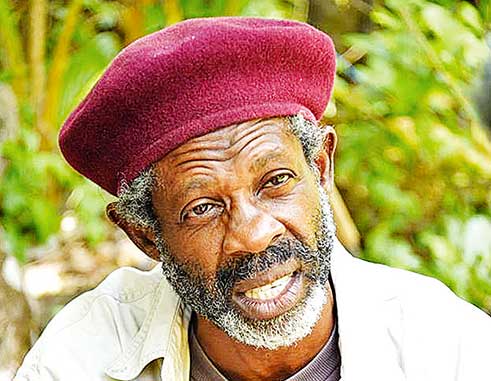“Nowadays things slow
Downsizing for so
Every businessman has one thing on his mind,
And it’s not his staff
If they cry or laugh
All he cares about, his bank account is his bottom line.
That’s the bottom line, that’s the bottom line”. (Mighty Pep and Seon, 2004).

Reflecting on the words of this local calypso by the Mighty Pep and Seon, in 2004, it would appear that, at the end of the day, all that the businessman is concerned about is the bottom line – his bank account. Conversely, popular perception is that the environmentalist doesn’t give a darn about the bottom line. In fact, both the businessman and the environmentalist are equally concerned with the bottom line. Nevertheless, the latter goes beyond the mirage (bank account) to the actual bottom line itself. In another stanza, the above-mentioned calypso goes, “The bottom line is the final straw,” and “when you can’t give no more.” It stands to reason that the real bottom line is the last resort – last resource, which is the focal point of the Green Movement (GM). So, the Green Movement strikes me as the social conscience or spectacles through which the business world ought to view the bottom line. The GM’s ethos and mission is to keep the business world in check by reminding them, to use the old adage: ‘you can’t kill the goose that lays the golden eggs’. In other words, the eggs are the end product, but the hen is the source. Therefore, to jeopardize the industry’s life is counter-productive for any business. That’s the bottom line.
The Green Movement (GM) seeks to keep the business world focused on the indubitable bottom line – the ultimate concern for the sustainability and longevity of the resources that generate the fleeting bottom line. This is why the synergy between the GM and the business world is not a dance of dichotomy as some have suggested, but rather, a symbiosis of sorts: as the environmentalists shape the business structure, so the business structure shapes the Green Movement. As a consequence, the squabble, if there is one, is a false quarrel. The entrepreneur’s capacity to exploit makes sustainability possible, but it’s the entrepreneur’s inclination to over-exploit which makes sustainability necessary. The law of Raspberry Jam is crucial here – The wider the industry is spread, the thinner it gets. Social scientists warn that environmental degradation is intrinsically tied to societal collapse. That’s the bottom line!
If the business world has to survive and avoid being submerged beneath the forces of the “Financial Tsunami” under which the global economy is still reeling, it must be guided by frugality, business ethics and a social conscience, without which its own bottom will certainly drop out – in effect, it will boom and bust. Consequently, the Green Movement exists not to mar the bottom line but to accentuate it, not to blow out but to blow up the bottom line. How so? The Green Movement invites the business world to adjust organically. In so doing, it shears ‘business as usual’ -to save itself from self-destruction- to replace it with a viable ‘unusual business’. As Albert Einstein aptly put it, “Not everything that can be counted counts and not everything that counts can be counted.”
The Green Movement is here to facilitate an integrated approach by the business world, which encompasses every aspect of production. Least the scale of the business world loses its balance; the Green Movement seeks to hold it accountable and responsible. Or rather, awaken in the business world a keener sense of duty and create a more acute awareness of its privileges and yes, its responsibility. The GM brings to the fore the sloppy practices of industry in order to curtail and remedy them before it’s too late. That’s the bottom line. So how does the Green Movement impinge on the bottom line? Whenever the business environment scales lose their equilibrium, it is the Green Movement’s aim to foster and help restore that delicate balance. For the impact on other nations and on the environment must also be assessed in the balance sheet – the good and the bad. The loss of biodiversity and degradation of the ecosystems exacerbate many of the key challenges we face in the 21st century, from freshwater provision and sustainable agricultural production for 9 billion people, to catastrophic climate change, regional conflicts and migration due to resource shortage. All these threaten the climate in the business landscape.
Thus, according to (Castro, 1990):
“The last three decades have increased public awareness of environmental issues. The awareness or green movement has prompted many industries to consider more environmentally sound ways of conducting business.”
Since then, these technique endeavor to pursue the three R’s of reduce, reuse, and recycle says, Coddington, 1990. The dynamics of the business world have changed irreversibly; persistent consumer interest in environmental concerns has made “greening” an important issue for managers and marketers. Several managers sight aspects of the green movement as possible niches for product marketing efforts.
Consider the following statements:
– Consider the contribution of travel and tourism to the Gross Domestic Product of the tourist-based economy of a Caribbean island like St. Lucia – 35.1% directly and indirectly in 2010 (World Travel and Tourism Council). Advisedly, the General Manager of Sandals Halcyon, Lennox Dupal asserts, “As the largest tourism investor in St. Lucia, we simply cannot afford to ignore the need to preserve the world and its environmental resources. If we turn a blind eye to the grave threats that the environment is under, we compromise the industry and by extension our very survival as a people”
(The Weekend Voice Newspaper, May 1st, 2010).
– “In an effort to protect its natural heritage from over-development, the Caribbean island’s government now has an environmental section in its ministry of planning and nearly 30 laws setting out restrictions on new construction. But Dolby, whose company, DCG Properties, is building the £400m Le Paradis next to the sleepy village of Praslin on St Lucia’s east coast, says he welcomes the safeguards.” “Spoil a place like this,” he says, sweeping his arm across a 550-acre vista, “and you spoil your greatest asset”
(Financial Times, 21 April 2007).
Nonetheless, others are cautiously optimistic for, to date, most of the attempts at capitalizing on the Green Movement have been focused on recycling products and environmentally friendly consumer products and packaging (Peattie-Priced and Ratnayaks, 1992). Many companies have looked to these as potential premium-price goods, but have found the market to be less receptive than expected (Wasik, 1992).
Let’s not kid ourselves. Even when the change is done organically, it carries a cost which impacts the bottom line and takes time for the market to warm up to it. Dr Magness, a professor in the school of Business Management of Ryerson University, asks, “Has the environmental movement created new costs for the corporate sector? The answer is clear; yes, it has. Have proponents of social responsibility accounted in general, or environmental accounting in particular, convinced companies to pursue social objectives without concerns for their economic responsibility? No. Any social benefit obtained without regard for corporate economic responsibility would be short-lived.” That’s the bottom line too.
However, according to the World Economic Forum report 2010, this loss of biodiversity and degradation of ecosystems has dramatic consequences for business:
• In 2007 the collapse of bee colonies was calculated to have cost US producers $15bn.
• The economic cost of soil erosion in Europe is estimated at €53 per hectare, per year.
• Annual economic losses caused by introduced agricultural pests in the US, UK, Australia, South Africa, India and Brazil exceeds US$100 billion.
Perhaps the jury is still out on the economic effects of the Green Movement on business, but what is certain is that the dialogue is in progress – the silence is broken. For instance, no longer can the – US$7.2 billion a year industry – Atlantic bluefin tuna be harvested for sushi and sashimi by Japanese fishermen and others without vigorous debate on the consequences. Gone are the days when businesses traded in ivory at approximately US $55 million per year with no questions asked, as it relates to wildlife protection.
In an article entitled ‘Save the Caribbean’s standing: Sink the yen for whales’, by Sir Ronald Sanders, he warns the Caribbean Governments thus:
“more importantly, the Caribbean sells itself to the global tourism market as environmentally friendly and protective of the natural wildlife – an assault on this latter reputation by tourist groups, who are increasingly demanding higher standards, could damage the region’s already fragile tourism industry.”
(The Weekend Voice Newspaper, May 1st, 2010)
The bottom line is, it is evident that the Green Movement has changed to some degree the way business people conduct their affairs, although, in most cases, the consumer is asked to stomach the environment levy. However, consider the following:
• Less than three decades ago, ‘sustainability’ was not in our local vocabulary nor in the national consciousness; today, supermarkets are offering green shopping bags in place of plastic bags.
• Although leaded gas was a cheaper product than unleaded in 1998 (EC$6.33 vs. EC$6.73), today it’s a commodity of the past.
• Special quarantine and quality control boards monitor pesticides and herbicides.
• Our wildlife and natural products such as parrots, coral, beach sand, turtles, iguanas and so on can’t be bought or sold, except through the back door.
• Eco-tourism is now central to the tourism business; in fact, it adds dollar value to the tourism product as biodiversity “hot spots”. The economic valuation of coral reefs direct impacts in St. Lucia for 2006 was 11% (US$91.6 million) of GDP.
• The Environmental Levy Act of 2002 was introduced to deal with solid waste disposal.
Greening the face of the business world is taking time, while sustainability is slowly weaving its way into the business cultural fabric because of the biological interdependence that binds all. Although the tension between sustainable exploitation and over-exploitation remains, there is a shift in the business web towards eco-efficiency in business in general and in the tourism industry in particular.













